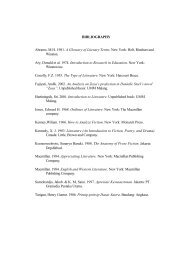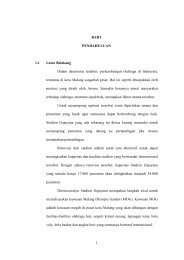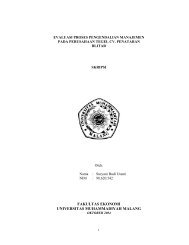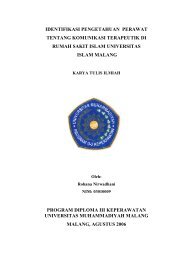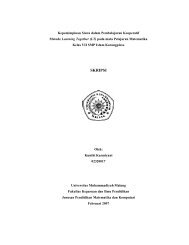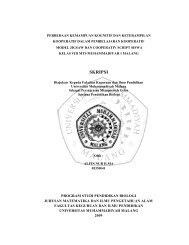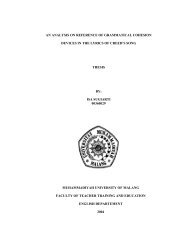File : THESIS.pdf - Universitas Muhammadiyah Malang
File : THESIS.pdf - Universitas Muhammadiyah Malang
File : THESIS.pdf - Universitas Muhammadiyah Malang
You also want an ePaper? Increase the reach of your titles
YUMPU automatically turns print PDFs into web optimized ePapers that Google loves.
sections, A to U.<br />
A Cell Structure<br />
B Biological Molecules<br />
C Enzymes<br />
D Cell Membranes and Transport<br />
E Cell and Nuclear Division<br />
F Genetic Control<br />
G Transport<br />
H Gas Exchange<br />
I Infectious Disease<br />
J Immunity<br />
K Ecology<br />
L Energy and Respiration<br />
M Photosynthesis<br />
N Regulation and Control<br />
O Inherited Change (Gene technology now in section R)<br />
P Selection and Evolution<br />
Applications of Biology<br />
Q Biodiversity and Conservation<br />
R Gene Technology (includes some material originally in O)<br />
S Biotechnology<br />
T Crop Plants<br />
U Aspects of Human Reproduction<br />
Papers 1 and 2 will assess the AS parts of the Core. Paper 4 will assess the A2 parts of the<br />
Core and Applications of Biology.<br />
The A2 parts of the syllabus, which will be examined only in the full Advanced Level<br />
qualification, are indicated in bold type in the subject content.<br />
The Applications of Biology section occupies about 12% of the full Advanced Level<br />
course. A booklet covering this section can be purchased from CIE.<br />
BIOLOGY 9700 A/AS LEVEL<br />
In order to specify the syllabus as precisely as possible and also to emphasise the<br />
importance of skills other than recall, Learning Outcomes have been used throughout. Each<br />
part of the syllabus is specified by a brief Contents section followed by detailed Learning<br />
Outcomes. It is hoped that this format will be helpful to teachers and students. It must be<br />
emphasised that the syllabus is not intended to be used as a teaching syllabus, nor is it<br />
intended to represent a teaching order.<br />
It is hoped that teachers will incorporate the social, environmental, economic and<br />
technological aspects of Biology wherever possible throughout the syllabus (see<br />
Aims 4 and<br />
5). Some examples are included in the syllabus and students should be encouraged to<br />
apply the principles of these examples to other situations introduced in the course.<br />
Inclusion of further examples in the syllabus has been resisted as this would merely<br />
increase the amount of factual recall required of students.<br />
Aim 5.4 emphasises the importance of Information Technology in this Biology course. It<br />
is hoped that students will make full use of IT techniques in their practical work.<br />
Teachers may also use IT in demonstrations and simulations.<br />
Everything that we know about Biology has been learned through practical<br />
investigation. Practical work is also motivating and interesting for learners, and can aid<br />
in understanding of abstract theoretical concepts. It is expected that practical activities<br />
will underpin the teaching of the whole syllabus. Asterisks (*) placed by learning outcomes<br />
in the syllabus content show parts of the subject that present particular occasions for practical<br />
work.<br />
114



